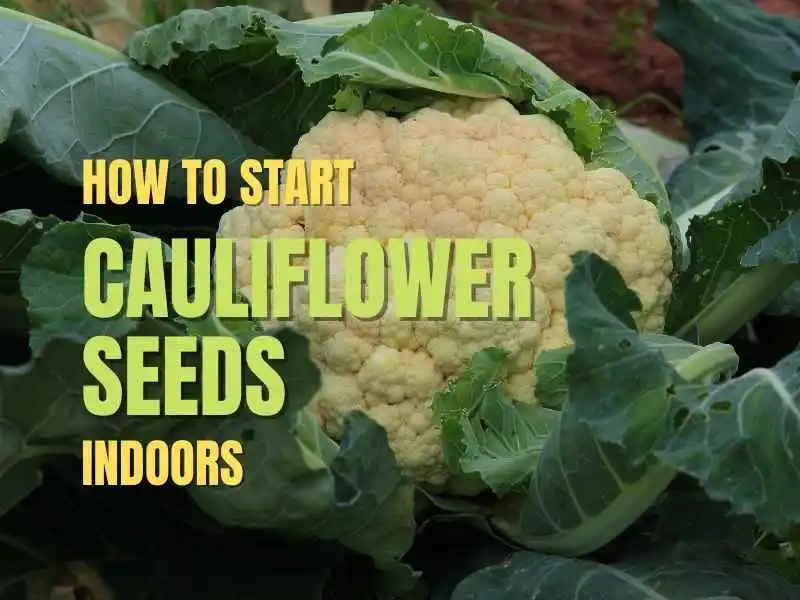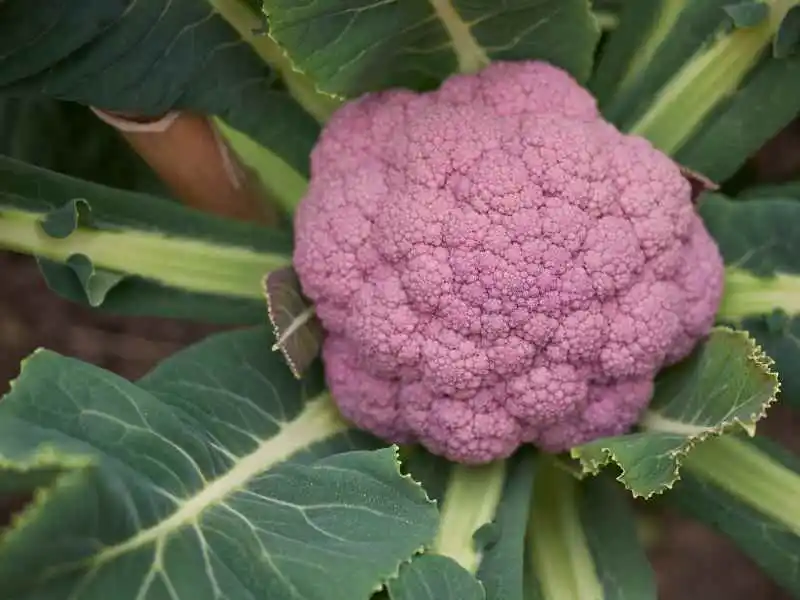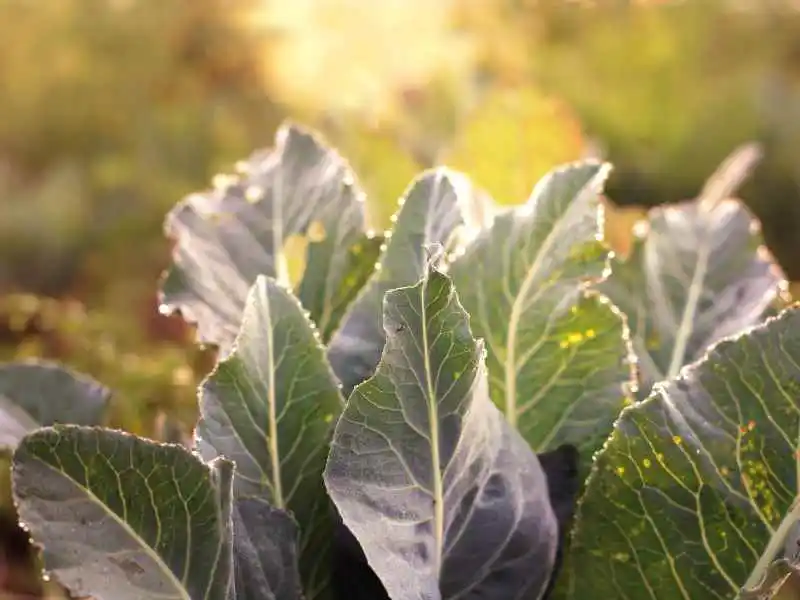Germinating Cauliflower seeds can be a little bit harder because of their sensitivity to temperature. It needs a moderate temperature, very cold or very hot temperatures can stop the plant’s growth.
It grows best at 15 to 20 degrees Celsius or 55 to 65 Degrees Fahrenheit. A temperature less than this will kill the plant. And the temperature above that will break the cabbage head into small white parts. In this article, we shall be looking at how to start cauliflower seeds indoors.

If you are a beginner you need to choose the best-growing variety of cauliflower. It needs healthy and deep rich soil for better growth. Start the sowing in modular trays. Growing the plant from seeds indoors in the early spring period and then transplanting it outside is a good way to start cauliflower.
Cauliflower Germination Time
A seed normally takes up to 8 to 10 days for germination. The whole cauliflower grows up to 50 to 85 days.
Growing Cauliflower from Seed
It is recommended to start sowing the cauliflower seeds in modular trays. Fill the tray with seed compost having lower nutrients than standard compost. Thoroughly rub the compost to avoid any lumps getting into the tray.
How many cauliflower seeds per hole
Settle the compost and make a small hole of about 1 and a half cm in each cell. Each cell could have up to 2 seeds. After sowing, cover it with another layer of compost. Water it gently and evenly to avoid any damage to the seeds. Heavy or uneven watering can wash away the seeds.
Now you can place the trays on the windowsill if you are growing indoors. Or else, you can also put them in a greenhouse or cold frame as per your choice and availability. From there, the seeds would take up to 4 weeks to be ready to get transplanted.
Growing Cauliflower Indoors
A better way to avoid the weather extremes is to start the cauliflower seeds indoors. You can start the sowing very early and then transplant it outside. It’s best to plant the cauliflower 4 to 7 weeks before the last frost.
Use good quality fertile soil for seed sowing and wrap the soil with plastic, then wait until the seeds sprout. It normally takes 8 to 10 days for the seeds to germinate. Remove the plastic wrap after the seedlings appear. Take care of the water requirement of the seedlings, and keep the soil evenly moist all the time.
ALSO, READ
HOW TO GROW CABBAGE AT HOME WITHOUT SEEDS
When to Start Cauliflower Seeds Indoors
It’s crucial to carefully start cauliflower at the right time of the season. Start at such a time that the plant should not mature in hot weather. For fall crops, start in early or mid-summer. Look for the last frost in spring, and plant the seeds indoors about 6 to 10 weeks before the frost.
After 2 to 3 weeks, transplant the seedlings into the plastic tunnel. Transplant the plant in the garden 3 to 4 weeks before the last frost. For the fall season, it’s better to start sowing seeds indoors 10 to 12 weeks before the last frost.
How to Care for Cauliflower Plants

When you are growing the cauliflower indoors, provide the proper heat and enough sunlight to the seedlings. If they get much heat and less sunlight they can get leggy, which means they turn into long spindly plants. Make sure to provide the proper heat and enough sunlight to avoid this problem.
Other factors also affect the growth of cauliflower. Any interruption or change in moisture, temperature or nutrition can result in premature head development. Water the plant regularly and use nitrogen-rich fertilizers 3 to 4 weeks after transplanting.
Planting Cauliflower Seeds
A few things are important to consider before planting cauliflower. First of all, the soil should be organic-rich. This plant also needs rich nutrients so add 5-10-10 fertilizers.
Seeds should be started 4 to 5 weeks before the last frost. The plant needs consistent water in both phases i.e. during germination and during growth. Seedlings should be transplanted 2 to 4 weeks before last spring’s frost and every plant should be 1.5 to 2 feet apart.
Grow Cauliflower In Grow Lights
When the seedlings appear, use growth lights directly over them. They need a lot of light for healthy growth. Provide at least 14 to 16 hours of light per day.
Improper and not enough light will result in leggy seedlings. Place the grow lights about 5 to 10 cm above the seedlings.
Hardening off Cauliflower
Before transplanting the seedlings outside in the garden soil, it is best to harden off the plant. This is because indoor plants are not used to the outdoor temperature and light conditions. Hardening off can be done using a mini greenhouse or in a plastic tunnel.
In the beginning, keep the plant covered for a longer period of time and then gradually expose them to the external temperature and sunlight by uncovering them. Slowly increase the exposure time. You can also use a simpler way to harden it off.
Just take the plant outside for about an hour a day initially and bring them back indoors then gradually increase this time. In extreme cold, this can be skipped. Follow this method for about 8 to 10 days before transplanting the plant outside. In mild-weather regions, hardening off is not mandatory.
Transplanting Cauliflower Seedlings
When the seedlings are about 4 to 6 inches long, it’s time to transplant the seedlings to the garden. Use the soil with a pH range of 6.0 to 7.5 to ensure better results. The garden soil should be kept well-manured, add a few inches of compost before you transplant the seedlings into the soil.
It’s important to keep the seedlings safe from extreme cold. For this purpose, cover the plant in a plastic tunnel for at least 2 weeks. After you have transplanted the seedlings in the garden, make sure to keep the soil moist all the time for the best growth results.
Soil Preparation for Cauliflower
The best soil for cauliflower should have a pH between 6.0 and 7.5. This plant needs moist, rich, and well-drained soil. Use organic fertilizers and provide the plant with potassium, phosphorus, and magnesium.
Spacing for Cauliflower Plants

There should be proper spacing between two cauliflower plants. Every two plants should have 15 inches of distance between them. If there are two or more rows, then each row should be about 2 feet apart.
Growing Cauliflower in Containers
Cauliflower can also be grown in containers if you don’t have enough garden space or you want to grow the plant indoors. Choose the right-sized container as the cauliflower plant needs a minimum of 18 inches of space in every direction to grow properly.
Select a container of a minimum of 20 inches in depth. This container must have drainage holes. Also, use good-quality drainage soil in the container.
Watering the Cauliflower
Cauliflower plants need proper watering. In the early stages when the seedlings are to be shifted to the ground or container, they should be watered properly. Don’t overwater the plant. Keep an eye on it and do not let the soil dry out completely. On hot days water the plant twice for better results.
Blanching
Blanching is a technique in which the white head of the cauliflower is covered so that the head remains bright and white as it grows. This is done when the head of the cauliflower has reached the size of an egg, look for the longest leaves of the plant, and cover the head with them.
Tie this up with some elastic bands. If blanching is not done during the growth of white cauliflower, the head will turn yellowish-white in color which does not look very pleasant. Varieties other than white cauliflowers do not need to be blanched.
Harvesting Cauliflower
The cauliflower plant usually takes about 50 to 100 days completely or 8 to 10 days after blanching, depending upon which variety you are growing. Before the harvest look at the head of the cauliflower, if it is compact and firm they are ready to be harvested.
If the head is 6 to 8 inches in diameter, take a knife and cut the head off, leaving a few inches of stem. Also, leave some of the leaves with the head to keep to protect them.
Storing the Cauliflower
Harvested cauliflower heads can be stored for a week, wrap them in a plastic bag, and place in the refrigerator. It can also be stored for a longer period of time by pickling the heads.
Recommended Varieties Of Cauliflower To Grow
If you are looking for an early-growing cauliflower variety go for the ‘Early snowball’. It also gives a good yield throughout the season. Graffiti and violet queens have purple-colored heads.
Self-blanching varieties include snow crown and Fremont. Cheddar and flame star are vitamin-A-rich varieties.
Pests and Diseases of Cauliflower
Now we shall look into a few pests and diseases that are usually found in cauliflower plants. Here is a list of some major diseases of cauliflower
Blackleg
This is a fungal disease that causes black or purple margins on lesions. This disease can spread down to the roots as well. Remove the affected area of the plant. Using disease-free seeds and before planting the seeds, treat them with hot water.
Clubroot
This is also a fungal disease caused by a fungus living in the soil. Symptoms include swollen roots and stunted and yellowish leaves. Using agricultural lime in the soil will help fight this disease.
Cauliflower mosaic virus
This viral disease is transmitted by aphids. Faded leaves and transparent veins are the clear signs of this disease. Using disease-free and certified seeds, and applying insecticides can be useful to overcome this problem.
Black rot
This is a bacterial disease caused because of damp weather. Initially, the margins of the leaves get yellowish and this can result in dried-out foliage. Discard the affected leaves and use good sanitation practices. Plant the seeds on a dry day.
White rust
Yellow blotches appearing on the leaf surface are the first sign of this fungal disease. These yellow spots turn brown and the leaves start to die. Remove the affected parts and dispose of them in sealed bags. The use of Neem oil and fungicides and placing the plant under the full sun can help reduce the chances of this disease.
Ringspot
This is a fungal disease resulting in the yellow margins on the foliage. Fungal colonization occurs which results in the blackening of leaves. Removing affected foliage and Applying appropriate fungicides can reduce the disease.
Powdery Mildew
A fungal disease that results in the appearance of a white coating on top of the leaves. The leaves turn yellow or brown and eventually lead to the death of the plant. Using balanced fertilizer and sulfur-based fungicides to prevent the spread of disease.
Downe mildew
Hyaloperonospora parasitica causes this disease which results in damaged foliage and heads. Yellow spots on leaf surfaces are the initial signs of Downe mildew. Remove affected leaves and plants. Apply fungicides and avoid using high-nitrogen fertilizers.
Bacterial Soft rot
As the name indicates, it is a bacterial disease that attacks the tissues of the plant. The affected plant develops soft wet spots on the leaves. Remove the affected part as this is the only solution to this problem. Using fresh water and not oversaturating the soil is the key to avoiding this disease.
Some commonly known pests are as under
Aphids
These insects are covered with a white waxy coating and they are visible on the plant leaves. Before transplanting look for the aphids, using reflective mulches also deter aphids from damaging the plant. Neem oil or insecticidal soaps are also the best controls for these pests.
Beet armyworms
The prominent symptom is the presence of a cluster of eggs on leaves. These pests cause circular or irregular-shaped holes in the foliage. The larvae are generally dark green in color. Using biological control such as Bacillus thuringiensis can be useful to overcome this problem.
Cabbage looper
These pale green caterpillars lay white or pale green eggs on the lower surface of the leaf. Again, biological control by using Bacillus thuringiensis can fight the spread of pests.
YOU MAY ALSO LIKE
How To Grow Cherry Tomatoes From Cherry Tomatoes
How To Grow Sungold Cherry Tomatoes In Containers
References

